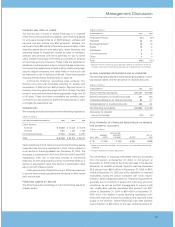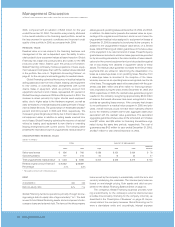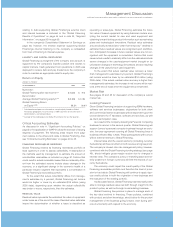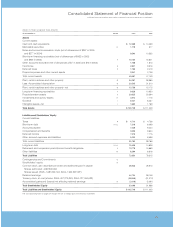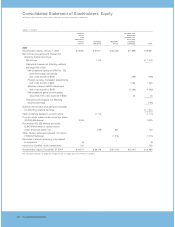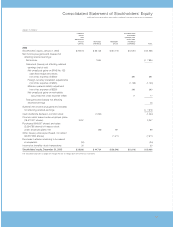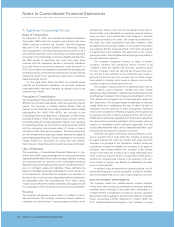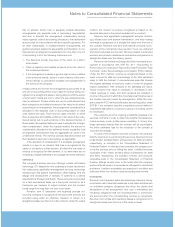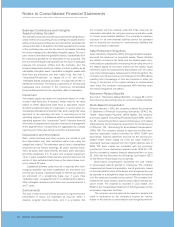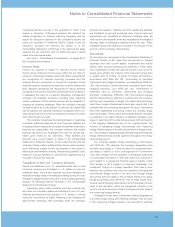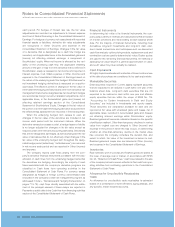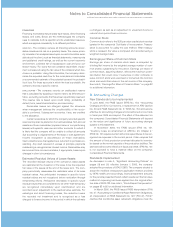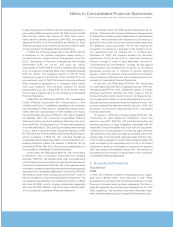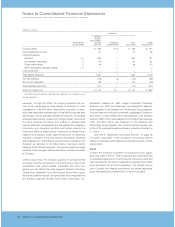IBM 2005 Annual Report Download - page 56
Download and view the complete annual report
Please find page 56 of the 2005 IBM annual report below. You can navigate through the pages in the report by either clicking on the pages listed below, or by using the keyword search tool below to find specific information within the annual report.
NotestoConsolidatedFinancialStatements
INTERNATIONALBUSINESSMACHINESCORPORATION ANDSUBSIDIARYCOMPANIES
_55
56) on whether and/or how to separate multiple-deliverable
arrangements into separate units of accounting (separability)
and how to allocate the arrangement consideration among
thoseseparateunitsofaccounting(allocation),thatdeliverable
isaccountedforinaccordancewithsuchspecificguidance.For
all other deliverables in multiple-element arrangements, the
guidancebelowisappliedforseparabilityandallocation.Amul-
tiple-elementarrangementisseparatedintomorethanoneunit
ofaccountingifallofthefollowingcriteriaaremet:
• The delivered item(s) has value to the client on a stand-
alonebasis.
• Thereisobjectiveandreliableevidenceof thefairvalueof
theundelivereditem(s).
• Ifthearrangementincludesageneralrightofreturnrelative
tothedelivereditem(s),deliveryorperformanceoftheunde-
livered item(s) is considered probable and substantially in
thecontrolofthecompany.
Ifthesecriteriaarenotmet, thearrangementisaccountedforas
oneunitofaccountingwhich would resultinrevenuebeingrec-
ognizedonastraight-linebasisor beingdeferreduntiltheearlier
ofwhensuchcriteriaaremet orwhenthelastundeliveredele-
mentisdelivered.If thesecriteriaaremetforeachelementand
thereisobjectiveandreliableevidenceoffairvalueforallunitsof
accountinginanarrangement,thearrangementconsiderationis
allocated to the separate units of accounting based on each
unit’srelativefairvalue.Theremaybecases,however,inwhich
thereisobjectiveandreliableevidenceoffairvalueoftheunde-
livereditem(s)butnosuchevidenceforthedelivereditem(s).In
thosecases,theresidualmethodisusedtoallocatethearrange-
ment consideration. Under the residual method, the amount of
considerationallocatedtothedelivereditem(s)equalsthetotal
arrangement consideration less the aggregate fair value of the
undelivered item(s). The revenue policies described below are
thenappliedtoeachunitofaccounting,asapplicable.
Iftheallocationofconsiderationinaprofitablearrangement
results in a loss on an element, that loss is recognized at the
earlierof(a)delivery ofthatelement,(b)whenthe first dollar of
revenueisrecognizedonthatelement,or(c)whenthereareno
remainingprofitableelementsinthearrangementtobedelivered.
SERVICES
The company’s primary services offerings include information
technology (IT) datacenter and business process transforma-
tionoutsourcing,applicationmanagementservices,technology
infrastructure and system maintenance, Web hosting, and the
design and development of complex IT systems to a client’s
specifications(DesignandBuild).Theseservicesareprovided
onatime-and-materialbasis,asafixed-price contract or asa
fixed-price per measure of output contract, and the contract
termsrangefromlessthanoneyeartotenyears.
Revenue from IT datacenter and business process out-
sourcingcontractsisrecognizedintheperiodtheservicesare
provided using either an objective measure of output or a
straight-linebasisoverthetermofthecontract.Undertheoutput
method, the amount of revenue recognized is based on the
servicesdeliveredintheperiodasstatedinthecontract.
Revenue from application management services, technol-
ogy infrastructure and system maintenance, and Web hosting
contractsisrecognizedonastraight-linebasisoverthetermof
thecontract.Revenuefromtime-and-materialcontractsisrec-
ognized at the contractual rates as labor hours are delivered
anddirectexpensesareincurred.Revenuerelatedtoextended
warrantyandproductmaintenancecontractsis recognizedona
straight-linebasisoverthedeliveryperiod.
Revenuefromfixed-priceDesignandBuildcontractsisrec-
ognized in accordance with SOP No. 81-1, “Accounting for
PerformanceofConstruction-TypeandCertainProduction-Type
Contracts,” underthepercentage-of-completion(POC)method.
Under the POC method, revenue is recognized based on the
costs incurred to date as a percentage of the total estimated
costs to fulfill the contract. If circumstances arise that change
theoriginalestimatesofrevenues,costs,orextentofprogress
toward completion, then revisions to the estimates are made.
These revisions may result in increases or decreases in esti-
mated revenues or costs, and such revisions are reflected in
incomeintheperiodinwhichthecircumstancesthatgiveriseto
the revision become known by management. While the com-
panyusesthePOCmethodasitsbasicaccountingpolicyunder
SOP81-1,thecompanyusesthecompleted-contractmethodif
reasonableestimatesforacontractorgroupofcontractscannot
bedeveloped.
Thecompanyperformsongoingprofitabilityanalysesofits
servicescontractsinordertodeterminewhetherthelatestesti-
mates-revenue, costs, profits-require updating. If, at any time,
these estimates indicate that the contract will be unprofitable,
the entire estimated loss for the remainder of the contract is
recordedimmediately.
Insomeofthecompany’sservicescontracts,thecompany
billstheclientpriortoperformingtheservices.Deferredincome
of$4.3 billionand$3.9billionatDecember31,2005and2004,
respectively, is included in the Consolidated Statement of
FinancialPosition.Inotherservicescontracts,thecompanyper-
formstheservicespriortobillingtheclient.Unbilled accounts
receivableof$1.7 billionand$1.9billionatDecember31,2005
and 2004, respectively, are included in Notes and accounts
receivable-trade in the Consolidated Statement of Financial
Position.Billingsusuallyoccurinthemonth afterthecompany
performstheservicesorinaccordancewithspecificcontractual
provisions.Unbilledreceivablesareexpectedtobebilledand
collectedwithinfourmonths,rarelyexceedingninemonths.
HARDWARE
Revenuefromhardwaresales and sales-typeleasesis recog-
nizedwhenriskoflosshastransferredtotheclientandthereare
no unfulfilled company obligations that affect the client’s final
acceptance of the arrangement. Any cost of warranties and
remaining obligations that are inconsequential or perfunctory
are accrued when the corresponding revenue is recognized.
Revenuefromrentalsandoperatingleasesisrecognizedona
straight-linebasisoverthetermoftherentalorlease.


